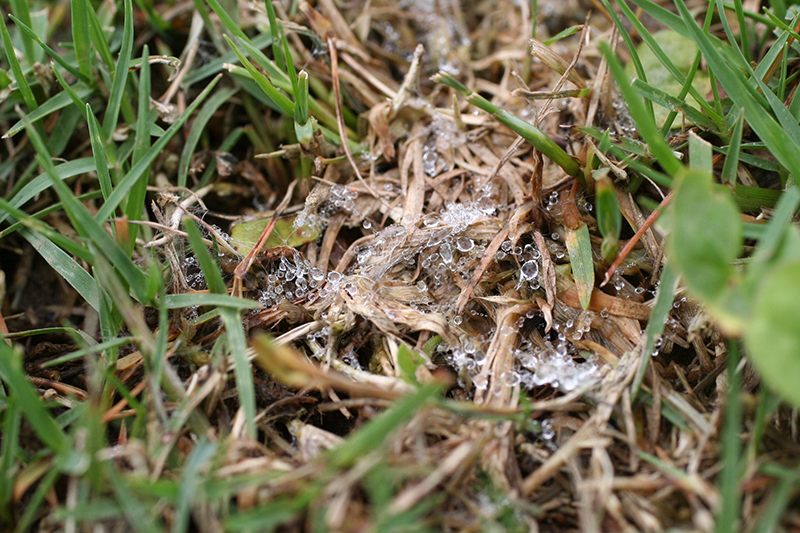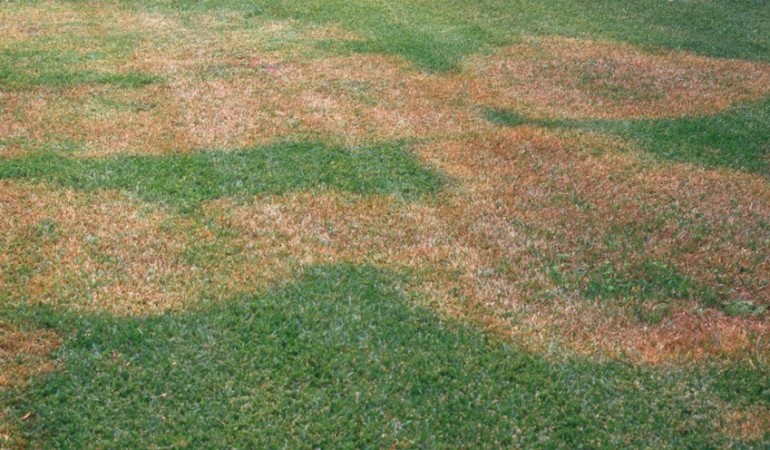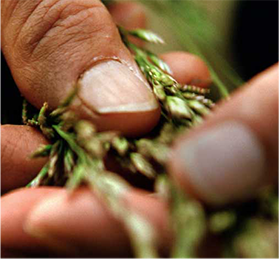Identifying and Preventing Common Lawn Diseases

Diseases that develop in home lawns are not typically a dangerous threat. Occasionally, however, an outbreak will occur after an extended period of heat and humidity that will instill a slight panic in a homeowner. However, for the most part, a home lawn will remain relatively disease-free if it is maintained properly, especially with adequate fertility. Golf courses and sports fields are way more susceptible to turf diseases due to their extensive use and intense conditioning, but rarely will a homeowner need to apply a fungicide to the lawn either as a preventative measure or as a treatment.
That being said, if there is a dead or dying spot in a lawn, it is always beneficial to know if it might be a disease or the result of something else altogether. Many time spots occur because of rather innocuous reasons such as frequent dog urination or any number of spilled substances that are unfriendly to grass. Knowing how to identify a lawn disease can provide valuable clues as to what might be causing its presence and what can and can’t be done about it.
Common Home Lawn Diseases
There are numerous diseases that can creep up on the home lawn if the proper conditions are present. There are literally complete books dedicated to them. Luckily, some are more way more likely to develop than others, so we’ll focus on those.
Brown Patch

Brown patch is one of the most common diseases that can pop up in a home lawn throughout the entire year. It appears as circular patches in the lawn that are brownish yellow in color and range from six inches to several feet in diameter. It affects all cool-season grasses but is especially harmful to ryegrass, Kentucky bluegrass, tall fescue and fine fescues. Each species is slightly different in terms of damage severity. Brown patch also affects a variety of warm-season grasses including St. Augustinegrass and Zoysiagrass. Brown patch is most likely to occur during the summer months with extended periods of heat and humidity when nighttime temperatures remain above 68° F. In the spring and fall, Brown patch can also develop when it’s rainy for extended time.
Red Thread
Another popular disease that deserves recognition is Red thread. It looks very much as its name suggests, with red or pink webbing or thread appearing in patches on the grass. Red thread is brought on by low levels of nitrogen in the soil. Overall, Red thread is a relatively harmless disease that can be used as a good indicator that it's time to fertilize. Cool-season grasses like tall and fine fescue, ryegrass, and Kentucky bluegrass are most susceptible.
Powdery Mildew
Powdery mildew is a disease common to many plants, each of which can be infected with its own species of the disease. Powdery mildew on lawns is most commonly found in cool-season turf; Kentucky bluegrass is especially prone to infestation. Powdery mildew can appear quickly on a lawn and mainly will be seen in shady areas, but it also can be more widespread and frequently during cloudy or overcast periods. Powdery mildew is extremely easy to diagnose because it appears as a white dust covering on the leaf blades. Other than looking fairly odd, this disease almost no harm to the plant.
Fairy Ring
Fairy rings are naturally occurring arcs of mushrooms in grassed areas or forests. It was given its unique name because, a long time ago, people thought actual fairies danced at night in the area which caused the mushrooms to develop (sigh).
The appearance of fairy ring can be incomplete or complete circles, which can grow to be over 30 feet in diameter. Fairy rings do not cause any widespread damage and are incredibly difficult to completely eradicate. Most often they are simply left alone to disappear as the conditions become unfavorable.
There are three types of fairy rings found on lawns:
- Those with only mushrooms
- Those with a darkened green ring and mushrooms
- Those with a darkened green ring, a zone of dying grass and mushrooms
Snow Mold
Snow mold is a common disease that appears in the early spring as the snow melts. It is caused when there is an extended period of snow cover on ground that is not completely frozen. When this condition happens, a pocket of air forms between the ground and the snow which serves as an ideal environment for snow mold to take hold. Additionally, snow mold also occurs under leaves that have not been clean up or amongst long grasses that should have been mown once more before winter set in.
There are two distinct types of snow mold: gray snow mold (also known as Typhula blight) and pink snow mold (also known as Fusarium patch).
Gray snow mold is fairly benign as it only infects the leaf tissue. It’s also the most prevalent of the two.
Pink snow mold is just plain nasty as it infects the crown of the plant and cause very severe injury that frequently result is lost areas of turf.
Prevention Strategies
The best preventative strategy for any lawn disease is good basic turf maintenance practices. It’s important to understand that once a lawn has an outbreak, it’s impossible to treat the symptoms that are visibly showing. So relying on sound cultural practices provides the best protection from occurring in the first place.
Here’s a quick list of cultural practices to help fight off diseases.
- Avoid applying too much nitrogen. There’s a fine line between adequate fertilizer and too much. Applying excessive amounts of nitrogen, especially fast-release, will encourage diseases and cause them to develop and spread quickly. A good quality slow-release nitrogen, applied at the proper time, will provide the best defense against diseases developing.
- Irrigate only when needed. Diseases love moisture…don’t unnecessarily help them. The general rule is to apply about one inch of water per week. The key to successful lawn irrigation is water infrequently and deep. Avoid only watering a little bit on a daily basis.
- Remove clippings. Typically removing the clippings is a bad idea, but when the weather is warm and moist, it’s the best way to prevent fungus spores from spreading throughout the entire home lawn.
- Mow regularly and at the proper height. While most people love to keep their home lawn short, it’s terrible in terms of disease management. The ideal home lawn should be 2 ½” to 3”. Also use the “1/3 rule” when it comes to how often the lawn should be mown…meaning do not remove more than 1/3 of the leaf blade in one cutting.
Treatment Options

Due to the expense of treating with fungicides and that most home lawns typically recover naturally, most lawn care experts say that fungicide treatments are appropriate for high-value areas. However, since many homeowners consider their home lawns high-value areas, they are a viable and effective way vastly improve the appearance and health of the turf. For the sake of ease in application, granular fungicides are the best option for most home lawns. The only caveat is that they must be irrigated after application with ½ inch of water to activate the chemical. Be sure to read and follow the product label directions.
In terms of the timing of application, the first application should be made immediately after the symptoms first appear, especially if hot and humid weather is expected. As with any chemical application, it’s best to spot-treat diseased areas rather than apply broadly over the entire lawn.
There are many excellent, broad-spectrum, granular fungicides that will control a wide variety of diseases throughout the growing season. LebanonTurf offers two home lawn solutions to help control diseases and keep it healthy all season.
- Lebanon PPZ .72G Fungicide – The active ingredient is propiconazole, which is a broad-spectrum, systemic fungicide that inhibits the synthesis of ergosterol, an important component of fungus cell walls, which stops the formation of the fungus growth.
- Lebanon Eagle .62G Fungicide – The active ingredient is myclobutanil, which is a broad-spectrum, systemic fungicide that blocks enzyme production, causing cell walls to break down, halting further growth of the fungus and eventual death.